The author and publisher have provided this e-book to you for your personal use only. You may not make this e-book publicly available in any way. Copyright infringement is against the law. If you believe the copy of this e-book you are reading infringes on the authors copyright, please notify the publisher at: http://us.macmillanusa.com/piracy.
FOR MY CHILDREN JONAS. SOPHIE AND EVA
Welcome to my quilting world of adorable paper-pieced animals.
Foundation paper piecing is a patchwork technique that allows you to create pictures with small pieces of fabric. It lets you sew those small pieces easily and accurately while being quite simple at the same time. It may seem daunting at first, but once you grasp the general concept, its actually really fun, relaxing and may prove to be addictive. And, for me, another favorite part of paper piecing quilt blocks is speed. You can create some stunning handmade pieces without having to invest the time in sewing an entire quilt.
Paper-pieced quilt block patterns are perfect for wall hangings, table runners, mug rugs, pillowcases, bags, framed art and so much more. These cute blocks give you ample opportunity to be creative and turn them into something very special and personal.
Working in the fashion industry for most of my adult life has greatly expanded my love for yarn and fabric. Im not a minimalist and was always drawn to rich colors and designs. Being exposed to a deeply rooted quilting community in North America while living there for a long time let me quickly evolve from simple shapes, such as squares and triangles, to more detailed blocks, such as the paper-pieced animals in this book. Experiencing these fascinating animals on my many travels across the globe inspired me to combine these beautiful animals with my love for quilting, resulting in these colorful animal quilt blocks for you to sew up in your favorite fabrics.
Dont be shy in your color combinations. Go by the Iris Apfel quote: More is more, less is a bore.
Animals are part of our lives, whether theyre our friends and companions, our helpers or we simply find them fascinating.
A world without animals is likely a world we wouldnt want to live in. They are not only amazing but also a joy to look at, so they are the perfect choice for something as lasting as a quilt block.
I have included some easier blocks, such as . These will be great to start your paper-piecing journey. If you are an experienced quilter, there are many blocks in this book that will inspire you to create tons of wonderful handmade items. I can assure you foundation paper piecing is not difficult or daunting; on the contrary, with the right tools, you will soon find it as much fun as I do.
So, get your sewing machine ready and let me introduce you to this fascinating technique.
As with any craft, a proper toolbox helps you immensely when working on your projects.
Paper piecing doesnt really require any fancy equipment, but a few tools will make your life a lot easier, so be sure to read this chapter and double-check whether theres anything essential thats missing from your toolbox.
THE BASICS
Sewing machine and sewing machine needles: Any standard sewing machine will work just fine for foundation paper piecing. I use size 80 sewing machine needles and change them often, since the paper dulls the needles fairly quickly.
Iron: An iron is essential when paper piecing; it gives you nice crisp seams and ensures a perfect quilt block. However, do not use steam, as it can distort your paper or fabric, or dissolve the printed pattern on your paper and leave stains on light-colored fabric!
Fabric: Foundation paper piecing is great for using smaller pieces of fabric. Many stores sell smaller pieces as fat quartersthis is a quarter of a yard of fabric, cut so it usually measures 18 x 22 inches (46 x 56 cm). A fat eighth would be half of a fat quarter. Depending on which way the fat quarter is cut in half, the fat eighth measures 9 x 22 inches (23 x 56 cm) or 11 x 18 inches (28 x 46 cm), but they arent always available for sale in stores.
PAPER
A lot of specialty papers are available for foundation paper piecing, and its easy to get lost or confused by all the variety. Its probably best to experiment with different papers to find out which you like best. I have worked with all sorts of papers and heres what I think:
Regular printer paper: At the moment, this is my paper choice. Its easy to use and cost effective; I use it in combination with a glue pen. And it is still thin enough to not be a headache when removing.
Freezer paper: This works great and is easy because you can just iron the fabric onto the paper and nothing slides off or moves, and obviously you dont need a glue pen. However, its fairly thick and can get pretty bulky, especially when small pieces are involved. Because of its thickness, its not as easy to remove afterward.
Foundation paper: Its wonderfully thin and perfect for tracing. It can also be used in your printer. Another advantage is that its very easy to remove when finished. However, it can become quite costly if you do a lot of paper piecing. And it tends to curl if ironed.
OTHER SUPPLIES
Lightbox (optional): This tool is only necessary if you do a lot of fussy cutting. It lets you place your template perfectly on your fabric.
Rotary cutter and cutting mat: You really cant have too many if youre sewing and cutting a lot. Pictured is a 12 x 12inch (31 x 31cm) rotating cutting mat. But I have large ones (23 x 34 inches [59 x 86 cm]) on every table in my sewing studio.
Good-quality craft scissors: Theres really nothing worse than dull scissors. I use good-quality embroidery scissors for cutting small pieces of fabric and threads. Dont use fabric scissors for cutting paper, please; it dulls your scissors.
Fabric glue pen: Since Im mostly working with regular paper, I use this pen all the time to glue the small pieces of fabric to the paper. I personally prefer using glue instead of pins. It also works fine with foundation paper.
Quilting rulers: There are tons of options out there. Those pictured are the ones I use all the time. The ADD-A-QUARTER ruler, with a -inch (6-mm) lip especially designed for paper piecing, gives you a perfect -inch (6-mm) seam allowance. My 6 x 23inch (15 x 59cm) Omnigrid quilting ruler also comes with metric measurements.

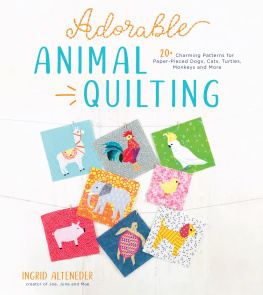
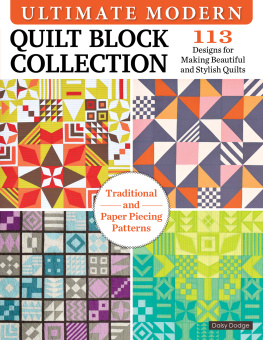

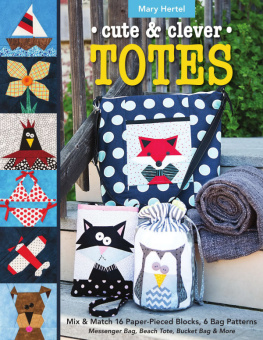


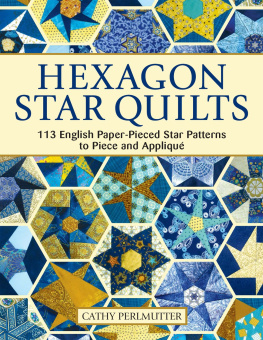
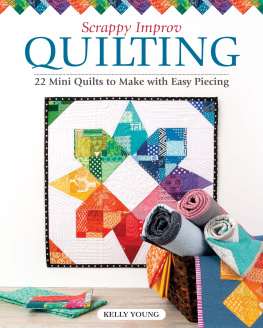
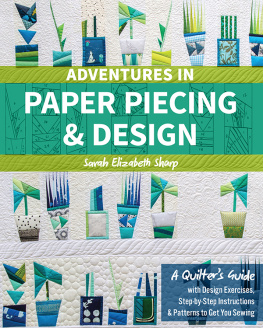
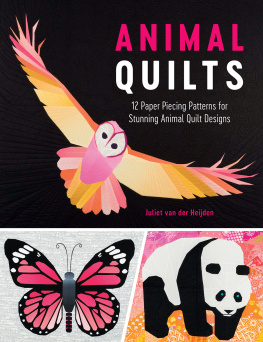


 QUILTING
QUILTING



